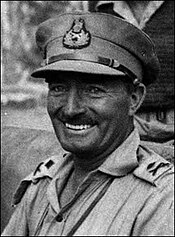George Erskine
Sir George Erskine | |
|---|---|
 | |
| Nickname(s) | "Bobby"[1] |
| Born | 23 August 1899 Hascombe, Surrey, England |
| Died | 29 August 1965 (aged 66) Rusper, West Sussex, England |
| Buried | Saint Mary Magdalene Churchyard, Rusper, Horsham District, West Sussex, England |
| Allegiance | |
| Service/ | |
| Years of service | 1918−1958 |
| Rank | General |
| Service number | 15806 |
| Unit | King's Royal Rifle Corps |
| Commands | 2nd Battalion, King's Royal Rifle Corps 69th Infantry Brigade 7th Armoured Division 43rd (Wessex) Infantry Division Commander of British Forces in Hong Kong British Troops in Egypt Eastern Command East Africa Command Southern Command |
| Battles/wars | World War I World War II Mau Mau Uprising |
| Awards | Knight Grand Cross of the Order of the Bath Knight Commander of the Order of the British Empire Distinguished Service Order Mentioned in despatches |
General Sir George Watkin Eben James Erskine GCB KBE DSO (23 August 1899 – 29 August 1965) was a senior British Army officer who is most notable for having commanded the 7th Armoured Division from 1943 to 1944 during World War II.
Early life and First World War
Erskine was the son of Major-General George Elphinstone Erskine by his second wife Eva Constance Sarah, daughter of Canon Ebenezer Wood Edwards. He was a descendant of the noted 18th-century jurist John Erskine of Carnock.[2]
Erskine was educated at Charterhouse School and later entered the Royal Military College, Sandhurst and was commissioned as a second lieutenant into the King's Royal Rifle Corps in 1918. He served during World War I in France and Belgium and attended the Staff College, Camberley from 1929 to 1930. During the 1930s he served in India but returned to Britain in 1937 to become Deputy Assistant Quartermaster General at Eastern Command.[3]
Second World War
In 1939 he became a General Staff Officer for 1st London Division of the Territorial Army (TA). In 1941 he was appointed Commanding Officer (CO) of the 2nd Battalion, King's Royal Rifle Corps who were then part of 69th Infantry Brigade and deployed to North Africa,[3] where he earned his Distinguished Service Order (DSO) in 1942.[2] He served as Brigadier General Staff (BGS) of XIII Corps, commanded successively by William Gott, a fellow officer of the KRRC, Brian Horrocks and Miles Dempsey, throughout most of 1942 and was then promoted to acting major-general on 24 January 1943[4] and was appointed General Officer Commanding (GOC) 7th Armoured Division. He served with the division in North Africa, Italy and Normandy between 1943 and 1944.[3]

During the Battle of Normandy in June and July 1944, however, the British Second Army commander, Lieutenant-General Miles Dempsey, was unimpressed with the 7th Armoured's performance and VIII Corps commander, Lieutenant-General Richard N. O'Connor, considered his direction of the division during Operation Goodwood as excessively cautious.[5] Shortly afterwards, in the difficult bocage country during Operation Bluecoat, the 7th Armoured Division failed to gain its objectives and Erskine was replaced by Gerald Lloyd-Verney. In spite of his indifferent performance as a field commander Erskine had qualities which suited him to other roles so that this episode proved only a temporary setback to his career.[5] He became Head of the Supreme Headquarters Allied Expeditionary Force Mission to Belgium in 1944 and then GOC 43rd (Wessex) Infantry Division in 1945.[3]
Postwar
After the war Erskine was Commander of British Forces in Hong Kong in 1946, Director General of the Territorial Army in 1948 to 1949 and GOC British Troops in Egypt in 1949. Returning to the United Kingdom, he became GOC-in-Chief, Eastern Command in 1952. In 1953 he was appointed GOC-in-Chief, East Africa Command where he was responsible for managing the response to the Mau Mau Uprising in Kenya and led Operation Anvil in Nairobi in April 1954. He was GOC-in-Chief, Southern Command from 1955 to 1958 when he retired.[3] He was an Aide-de-Camp General to the Queen from 1955 to 1965.[2]

Erskine was appointed Knight Commander of the Order of the British Empire (KBE) in 1950, a Knight Commander of the Order of the Bath (KCB) in 1952 and a Knight Grand Cross of the Order of the Bath (GCB) in 1955.[2] From 1958 to 1963 he was Lieutenant Governor and Commander-in-Chief of Jersey.[3]
Family
Erskine married Ruby de la Rue, daughter of Sir Evelyn de la Rue, 2nd Baronet, in 1930. They had two sons and one daughter.[2]
See also
References
- ^ Mead, p. 129.
- ^ a b c d e thepeerage.com General Sir George Watkin Eben James Erskine
- ^ a b c d e f Liddell Hart Centre for Military Archives
- ^ "No. 35928". The London Gazette (Supplement). 23 February 1943.
- ^ a b Mead, p. 131.
References
- Mead, Richard (2007). Churchill's Lions: a biographical guide to the key British generals of World War II. Stroud (UK): Spellmount. ISBN 978-1-86227-431-0.
- Smart, Nick (2005). Biographical Dictionary of British Generals of the Second World War. Barnesley: Pen & Sword. ISBN 1844150496.
External links
- 1899 births
- 1965 deaths
- British Army generals of World War II
- British Army personnel of World War I
- British people of the Mau Mau Uprising
- Companions of the Distinguished Service Order
- Clan Erskine
- Governors of Jersey
- Graduates of the Royal Military College, Sandhurst
- Graduates of the Staff College, Camberley
- King's Royal Rifle Corps officers
- Knights Commander of the Order of the British Empire
- Knights Grand Cross of the Order of the Bath
- Operation Overlord people
- People educated at Charterhouse School
- People from Surrey
